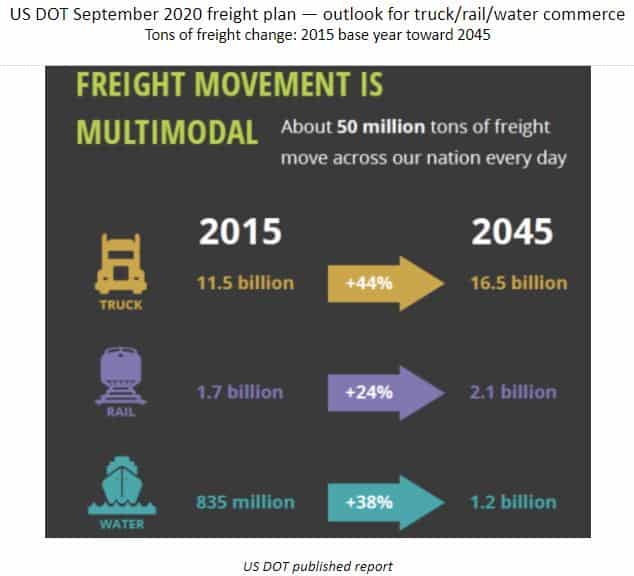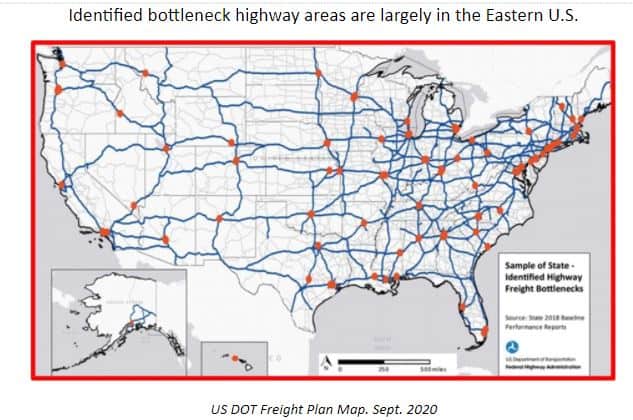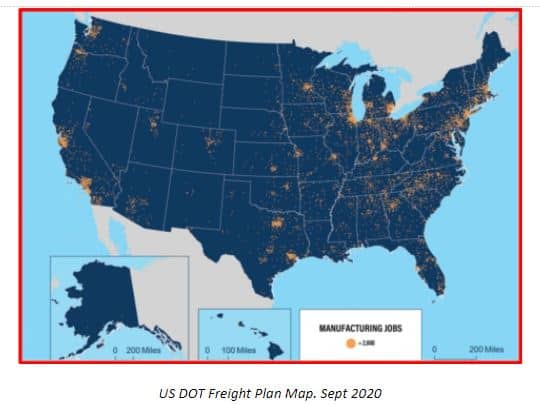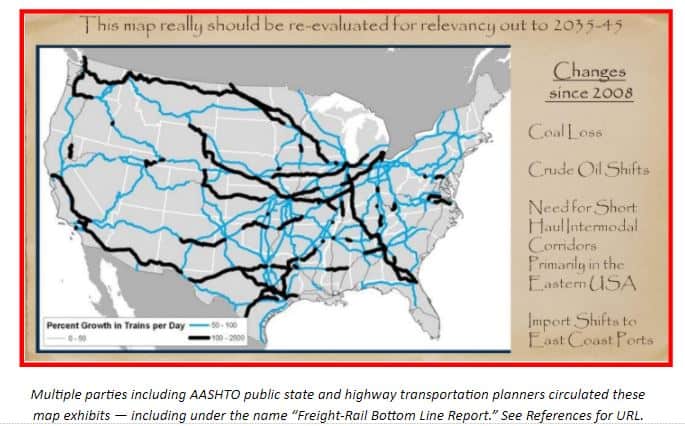The views expressed here are solely those of the author and do not necessarily represent the views of FreightWaves or its affiliates.
In early September, the U.S. Department of Transportation (DOT) published an updated national freight plan. Was that a big deal or a little deal? Well, if states, towns and private companies want to obtain possible federal grants and/or loans for any transport projects (including rail), yes, it is an important benchmark.
Let us recite what the national “plan” document could enable. First, what’s the document all about: It is a position statement that after about five years since the previous DOT strategy document was released, this update presents a fresh perspective about the market outlook for goods movement and the challenges ahead.
However, it is not actually a concrete and specific plan. It’s mostly an outlook discussion with some data points and metrics about market scope and size.

No. It is not actually a committed funding program to get things built. Consider it instead a statement of possible intent. Perhaps directional changes.
Importantly, it is intended to incite logical and sometimes contrary discussion.
Railway and this revised DOT outlook
What does the report tell us commercially about the railroad industry sector and its future role and possible requirements for improvement?
Well, one interpretation is that the railroad freight role is likely to be somewhat limited over the next several decades.
That is this columnist’s market-strategic interpretation of the report.
Note — this column does not offer a translation that either the government(s) or the industry sector would agree with.
If we examine the report’s statistics and graphs, it is clear that rail freight is not now and may not in the future play the leading “mode” transport role.
If we look back over the previous decades, the rail role has been diminishing as to market share of volume. That’s suggested by Washington government analysts to continue.
Others in Washington might disagree.
But this analyst’s interpretation is that the plan suggests no railway sector rebirth or confirmed market share grab rail freight role ahead.
Yes, rail might take market share from trucking or possibly waterborne commerce in some “corridors,” but nothing in the federal story suggests that this will in fact happen.
There is, however, one important finding by DOT.
The federal analysis confirms that the railroad private track infrastructure (lines of steel rails, bridges and tunnels, and other hard fixed assets) are in better physical shape than are our nation’s locks and dams, and highways.
That is a rail sector business case advantage.
But a good-condition assets base by itself doesn’t guarantee a mode shift from highways or water transport modes back to railroad.
That traffic mode diversion strategy long advertised as coming by railroad executives remains a big challenge.
Not much evidence exists that this has been happening over the past five years. Selectively in intermodal? Yes. However, no overwhelming rail intermodal market share gain from the highways in the recent period. Why not?
A number of the railroads seem much more focused on margin preservation versus growing their share of the market volume (as discussed in previous RR market view FreightWaves columns).
Somewhat ironically, the railroads’ most noticeable strategic strength is its hard-won battle to become the strongest of the modes in financial terms.
They have as a group learned how to earn from their customers the rail industry’s cost of invested capital. As a result, there are strategic and public policy consequences.

As further geographic market evidence of where the commodity flow demand will be, here is a map showing the concentration of the manufacturing industry.
Figure 3 (below) shows manufacturing activity as signified by the pattern of jobs. How will rail freight grow as a service sector in such subregions?

We can clearly see where the demand corridors will be located. The challenge then becomes to see how this matches up with future rail service.
Can or will the railroads step up with a short-haul solution? Are such selected short-distance markets in their economic tool bag?When will we know?
What are your commercial views as to the railroad capabilities? Are you engaged yet in reconsidering these issues in policy and tactics discussions with Washington technical and policy analysts?
Have you elected yet to reassess the commercial cost and benefits of already conceptualized local state and urban goods movement region plans for railroads?
One other argument suggests the need for reevaluation of strategic rail investment needs.
Figure 4, below, identifies where the expected rail capacity growth would be needed when strategic planners huddled back in the 2004 to 2008 period.
Actually, this was a groundbreaking railroad analysis at the time.
However, beginning sometime after 2006 to 2009, the national marketplace for U.S. railroad traffic shifted. Key commodity routes like Powder River Wyoming coal origin traffic flows changed — as did eastern U.S. origin utility coal flows.
More recently, imports of Pacific containers have migrated toward the Gulf Coast and the Atlantic Ocean U.S. ports as shippers diversified their supply chains away in part from the Pacific U.S. ports.
Rail corridors that were to grow heavy future volumes of train per-day traffic now face a new market view.
Therefore, it is now time to reexamine the former strategic market change assumptions.
This fits right into DOT’s 2020 call for discussion.

Here is the major conclusion offered in this week’s rail freight market long-term view. DOT has tendered a document that bears serious reading.
Collectively, we can “officially” re-vet our previous freight logistics data assumptions and the capacity and market demand outlooks. Here for the rail sector. DOT Secretary Elaine Chao asked for our feedback. She did not give us a fixed solution.
As we close this discussion, here is a summary of the DOT outlook toward year 2045 from their report.

Note: Rail freight looks to grow about 25% when using DOT economic formulas. Trucking is closer to a one-third increase. That will not be a railway market share gain. What is rail industry management’s response to this outlook?
Economic recommendations
DOT has afforded the rail community an opportunity to comment. Who, colleagues, is going to step up and offer contrarian ideas? Not to trash in-place initiatives.
No. Many CAPEX rail initiatives already underway or completed are simply sunk costs. Let’s try to earn a return from them as they were designed.
Instead, let us seriously consider what’s happened or is now occurring in today’s marketplace that could make a difference already in the path ahead.
For the railroad company boards and senior officers, their challenge is to consider how to reallocate cash flow into growth projects that might best be self-funded.
Asking for government assistance might logically for many projects no longer be appropriate.
Public agencies being asked to partially fund PPP rail freight projects not yet under formal negotiated terms and conditions contracts perhaps should retest the projects’ financial feasibility. Use something other than just a do-or-do-not net present value financial model to estimate cash flows. Instead, consider using cost center and pro forma profitability models for a deeper understanding of which PPP party obtains cost versus benefits — and the risk-sharing agreement terms.
If you are interested, give me a call. I’d like to help. After all, I have sat during my rich career at most of the table sides from MPO (CATS) to state DOT (I-DOT) to federal (USRA) to rail carrier (CONRAIL) to engineering consultancy (Zeta Tech) and even on behalf of selective shippers.
I’ll volunteer.
As always, please share your optional opinion and reasons why. That’s how we both learn.
Recommended references:
Readers are encouraged to read the executive summary of the DOT plan point of view: https://www.transportation.gov/sites/dot.gov/files/2020-09/NFSP_execsum_508.pdf
Or they may read the entire report of just over 100 pages here: https://www.transportation.gov/sites/dot.gov/files/2020-09/NFSP_fullplan_508.pdf
Previous documented studies recommended for reading include:
AASHTO and others; Freight-Rail Bottom Line Report: https://www.camsys.com/publications/case-studies/freight-rail-bottom-line-report
Also, check for selected more recent changed strategic assumptions offered by the consultants, working with some of the state DOTs.











Brian Watt
To me, clearly the poster child for artificially clogged rail freight arteries would be the section of former Chicago, Rock Island & Pacific property extending from Utica IL to Joliet IL. This parallels Interstate 80 for the entire 60 miles. This once fluid two-way former Class I railroad has been reduced to being “a very long industrial siding” while daily 12,000 trucks transit along I-80. CSXT created this situation during geopolitical wars with the former ATSF railroad, as ATSF pushed east acquiring the TP & W further south.
Without going into more detail here, the result was permanently and artificially disabling a key piece of railroad by placing a paper tariff barrier at Utica IL. The barrier disallows westbound movement of traffic to the advantage of the tenant operator, CSXT. This barrier single-handedly killed a $ 36 million dollar private intermodal investment at Seneca IL known as I-80 Railport. For CSXT pique, the region from Council Bluffs IA to Joliet IL suffers with sub-standard rail service and inflated truck congestion. The entire State of Iowa does not have one decent intermodal facility within the state that matters as a result. Contact me for details. I am a first-hand witness. Details can also be viewed in the State of Illinois “Illinois Valley Commuter Rail” report.
Joe Selhorst
The trains are too long. They block highway traffic crossings way too long and we have no way of telling how long the crossing will be closed. It would be very helpful if they could get a citizen band radio so the engineers could at least give us an idea how long the crossings would be closed….we truckers have schedules also. Many thanks for your time.